The major contributing factor to the success of the summer’s new Faust
is the inspired leadership by the festival’s Chief Conductor FrÈdÈric
Chaslin. It is safe to say that the Gounod opus is probably on no one’s short
list of the greatest operas of all time, but mercifully the Maestro didn’t
get that memo, for he approaches the piece with a ferocity, commitment,
spiritual depth, and import usually reserved for the likes of Tristan
or Otello. The result is as musically fine a Faust as you are
likely to encounter in a lifetime of opera-going. The Santa Fe musicians
responded with a reading of blazing intensity and lustrous detail. Chorus
Master Susanne Sheston was a skilled and willing partner, and she had drilled
her full-throated ensemble of Young Artists to a fare-thee-well.
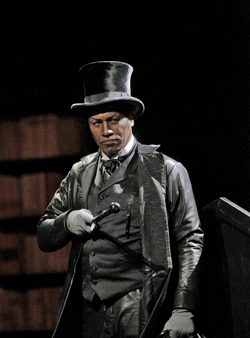 Mark Doss (MÈphistophÈlËs)
Mark Doss (MÈphistophÈlËs)
Bryan Hymel offered a polished, perhaps even definitive performance as
Faust, his gleaming, evenly-produced lyric voice capable of enough heft to ride
the orchestra in the heavier passages, especially above the staff. Mr. Hymel
also boasts one of the best, surefire, high C’s in the business. That said,
he did little to suggest the old man in the opening scene either physically or
with vocal coloring. The voice was so robust, so unvaried that at first I
wondered if his straight forward presentational style would wear well for an
entire evening. But once he was transformed to the young man, Hymel found the
requisite nuance, variety, subtlety and heart to wed to his beautifully
produced vocal lines. His French was also quite good, although he does need to
watch that “morte” not become “mahrt” nor “sans” become “sahn.”
Bryan does have an easy stage deportment and good natural interpretive
instincts that serve him well. It is easy to see why this exciting young tenor
is moving around the world in major assignments. Watch for him.
Beauty-contest-pretty Ailyn PÈrez has a voice that matches, and her creamy,
responsive soprano proved to be ideal for Marguerite. Okay, the quick moving
melismas were perhaps a little fudged in the Jewel Song but Ms. PÈrez has
discovered a meaning to every phrase, and weds them together to etch an
unusually rich, well-rounded character. She is not only capable of suggesting
the naive, inexperienced young girl, but also has all the dramatic power (and
interpretive gifts) to move us to the core as she descends to become the ruined
young woman. Although she finds great variety in the role, and explores ever
dramatic beat to the fullest, I suggest that in the first two scenes, Ailyn
might offer a little more full-bodied tone on certain understated utterances
and not treat them like they might break if pressed with a bit more urgency.
But hers was an accomplished, moving, highly satisfying Marguerite.
We were similarly blessed with our Valentin, Christopher Magiera embodying
the soldier with a manly, vibrant baritone of uncommon distinction. His
“Avant de quitter” was a high point of the show, with ringing top notes,
and his death scene was undeniably affecting. Jennifer Holloway may be on her
way to assuming Susan Graham’s French-singing mantle if her warmly sung,
impetuous SiÈbel is any indication. In addition to her exemplary mezzo, the
slim Ms. Holloway is perfect at impersonating a young man. Jamie Barton brought
a refined alto and a good sense of comedy to a successful, non-sterotypical
take on Marthe. Young Artist Darik Knutsen held his own in this stellar
company, with a solidly sung, theatrically engaged Wagner.
There is so much I really liked about Mark S. Doss as a larger-than-death
MÈphistophÈlËs: a seasoned command of the stage, untiring invention of stage
business, a powerhouse of a tremulously dark bass, and a thorough understanding
of the role and all the possibilities it contains. With so many plusses, I only
wish that Mr. Doss had not resorted to mugging, focus-grabbing, and making
Snidely Whiplash faces. Since his ringing bass is absolutely the right type,
and his technique is so sound, he could easily be numbered among the leading
proponents of the role. A little less would be so much more in this already
commanding performance. But perhaps, Mark is really only doing what his
director has asked of him?
Stephen Lawless has not often gone for subtlety in this staging, and the
whole comes across as over-produced, with enough ideas for several stagings of
Faust. WIth maybe a little Perichole left over. Set designer
Benoit Dugardyn has a field day (and apparently a big budget) as he first
provides an open peforming space flanked by legs of bookcases oveflowing with
books, which he then fills with set pieces that either rise up from the
basement or roll in from the sides, get revealed upstage center by parting
panels, or all three at once. The most unifying inset is the coffin that rises
from the floor center stage and serves as Faust’s desk, the basis of a flower
garden plot, a bed, and even (*gasp*) a coffin!
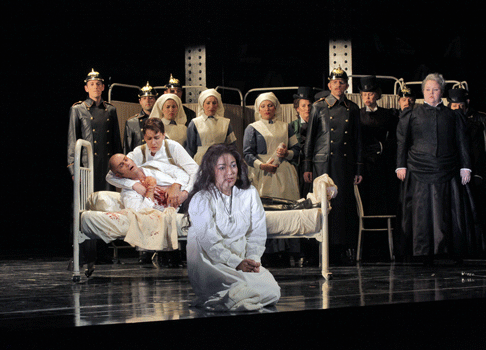 Background left: Matthew Worth (Valentin), Jennifer Holloway (SiÈbel) & Chorus, Foreground: Ailyn PÈrez (Marguerite)
Background left: Matthew Worth (Valentin), Jennifer Holloway (SiÈbel) & Chorus, Foreground: Ailyn PÈrez (Marguerite)
Second most used effect were rolling glass-and-painted backdrop museum
display cases that start out housing sideshow freaks at the Kermesse, reappear
stuffed with jewels as a Bijouterie for Marguerite’s aria, and come back in
the Walpurgisnacht bearing six of history’s most notorious femmes fatales. As
if this weren’t enough there was a large upstage Ferris Wheel with disco
lighting, a rotating house with bed for Faust’s seduction of Marguerite,
hospital beds and screens, a pipe organ and later, oversize organ pipes that
Marguerite climbs like the steps to heaven. When the devil sings Le Veau
d’Or he does it riding on a carousel version of a golden calf, flanked
by four other merry-go-round horses bearing choristers. Oh, and there is a
got-to-have-cost-a-franc-or-two wheelchair for Old Man Faust that has more
moves than a Busta Rhymes video. It sits up, it lays down, it rolls, it tilts,
it floats, it does everything but stand on its head and whistle “Dixie.” Is
all this necessary? (It did occur to me that the trick chair might serve the
company well if they ever mount Sweeney Todd.)
Sue Wilmington’s late 19th Century costumes worked less hard, were
wonderfully detailed, and made a real contribution. Her attire for
Marguerite’s early scenes made her look radiant. And the period military
costumes were spot on. The specialty costumes for Salome, Manon, Cleopatra,
etc. and all the other dancers that peopled Faust’s nightmare were well
crafted and supportive of the concept. Nicola Bowie’s choreography resorted
to simplistic steps for the iconic bad girls reducing the scene to a kitschy
bitch fight and a dispassionate stroke fest, a bad idea gone wrong.
To be fair to director Lawless, he almost always maintained a good focus on
the primary action, in spite of crowding it with effects. More often than not,
character relationships and plot developments were well reflected in the
blocking. A few of the devil’s surprise entrances are delightful like when he
is revealed under a sheet in the hospital ward, or pops up out of the coffin.
At other times, the placement of the scenic elements necessitated awkward,
unmotivatable movement to simply get the performers to the scenery. But despite
the hubbub and the well-intended visuals, nothing could distract this listener
from the ravishing musical achievement.
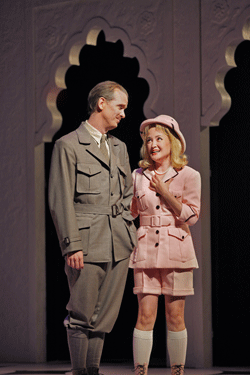 Kevin Burdette (Mr. Scattergood) & Anna Christy (Kitty)
Kevin Burdette (Mr. Scattergood) & Anna Christy (Kitty)
Had the chat phrase LMAO not already been in usage, someone would have had
to coin it to describe the response to the flawless production of Menotti
rarity, The Last Savage. This may not be great opera, but it was a
terrific time in the theatre. Allen Moyer’s scenery featured a fairy tale mix
of a palace in India, a sleek Chicago penthouse with glittering skyline, and a
comic book cave in the jungle. His eye-popping riff on Indian costumes rivaled
Bollywood, and the witty 60’s attire was a spot-on evocation of that
psychedlic fashion period. It was a stroke of genius to costume the dancing
chorus as tattooed (body suit) swamis, sporting turban, beard and diaper and,
all evening long, performing the loopiest, dizziest, funniest dance steps
since. . .well. . .Santa Fe’s Platee. Se·n Curran’s inventive
choreography never wears out its welcome, and is a constant ripe source of
titters and belly laughs (I am giggling as I write).
Director Ned Canty makes nary a false move as he steers his exceptionally
gifted cast of comedians-who-happen-to-sing-opera around the stage. His
handling of the large (really large) group scenes is nothing short of
astounding, especially Act Two’s cocktail party, in which it seems as though
everyone in the Young Artist program, or maybe even the greater Santa Fe Metro
area, has been given a cameo to perform. Mr. Canty’s ability to focus our
attention where it needs to be, and to move the massive forces around the stage
was. . .well, let’s just say he could be a successful air traffic controller
at any airport on the eastern seaboard. Not sure who was responsible for the
Connie and Carla moment (when a club audience suddenly throws arms in
the air en masse, Lupone-like on “Don’t Cry for Me, Argentina”), but when
the packed stage of ‘sophisticates’ suddenly did this goofy
jazz-hands-swaying-in-the-air-move in perfect unison, this veiwer was, well,
LMAO.
And what a cast! As Mr. Scattergood, Kevin Burdette is displaying one of the
best physical comedy performances since Dick Van Dyke reigned supreme. All
loose limbs, and with shameless deadpan timing, Mr. Burdette is such an
excellent comic actor, you almost forget how beautifully he is singing, in a
robust, immensely satisfying baritone. His ‘daughter’ Kitty (written for
Roberta Peters) is a perfect fit for petite, blond Anna Christy. One of the
opera’s running jokes is a spoof on show-offy, meaningless coloratura
displays, and Ms. Christy commands a well-schooled, flute-like soprano that
tosses these off with aplomb. Mr. Moyer also has a field day costuming the
lovely Anna, first in a pink, short-shorts version of a safari outfit with pith
helmet and designer boots (that Lady Gaga might actually wear), then baby doll
PJ’s that allow for a cheeky Kitten-with-a-Whip moment, and even an animal
print sarong that is one part Sheena Queen of the Jungle and one part
Victoria’s Secret. Ms. Christy is so committed, and sings so effortlessly
that she breezes us along through even the most preposterous plot points.
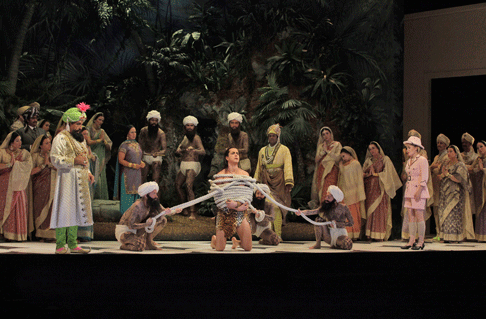 Thomas Hammons (Maharajah), Jennifer Zetlan (Sardula), Daniel Okulitch (Abdul), Sean Panikkar (Kodanda) & Anna Christy (Kitty)
Thomas Hammons (Maharajah), Jennifer Zetlan (Sardula), Daniel Okulitch (Abdul), Sean Panikkar (Kodanda) & Anna Christy (Kitty)
Thomas Hammons puts his buffo abilities to excellent purpose as the
Maharaja, managing to land even the most sexist marital observations. As the
corpulent, sedan bound, Maharanee, Jamie Barton had a field day, and her
full-throated mezzo rang out in the house. When she did alight from her perch
and revealed her full measure (the well padded costume recalled Jane Eaglen in
a biiiiiiiiiiig hoop skirt) , she struck real comedic sparks with Mr. Burdette.
Young tenor Sean Panikkar was a perfect Prince Kodanda, charming, dashing, and
possessed of a crystal clear tenor that he used in excellent service to one of
the night’s best arias. As the greedy servant girl Sardula, Jennifer Zetlan
made the most of perhaps the least well-drawn character, who starts off as a
comic antagonist, then reverts to rather an unpleasant harridan, and later
softens to fall in love with Kodanda. Ms. Zetlan’s silvery lyric voice was a
good match for one of the show’s most extended arias, and she managed to
imbue it with more interest than its generic sentiments invited.
So, what of the title character, the savage (Abdul, written for imposing
voice of George London)? Boyishly appealing Daniel Okulitch is a hard-working,
well-prepared performer. There is never a moment that he is not completely
engaged, and he brings a savvy stage presence to all he does. Based on one
hearing, this role may actually be less interesting than others in the opera.
There is a lot of reaction to him, a lot of talking about him, but in some
scenes like the party, there are long stretches in which he gets upstaged by
the writing for other momentarily featured characters. Mr. Okulitch certainly
had his day in the kissing lesson scene, and was madly wacky at the end of Two
where he tears the penthouse window curtain down, invades the skyline and
climbs a skyscraper a la King Kong. Full advantage was taken of Daniel’s
lean, muscled physique, an asset he is not shy about sharing (although, when
there was a reference to how hairy he was, it must have been written before his
chest got perfectly waxed. . .). The gifted baritone brought a luminous voice
to Act Three’s duet with Kitty, and was a key component in the sensitive
musings of a beautifully presented setpet, perhaps the best number in the
piece.
George Manahan got fine results from the orchestra, who played with flair,
delicacy, and oozing lyricism as required. Mr. Menotti has composed a hybrid
opera that intentionally incorporates bits and bobs of almost every composer
who has ever lived. After a nod to Rossini/Donizetti in the early part of the
overture the brass licks emulate Prokofieff, and just as suddenly Puccini seems
to have arrived. The penthouse jazz segments paid homage to Bernstein, and the
send-up of mid-century ‘modern’ music was so devastatingly correct it could
have been an actual quote of…Stockhausen? Babbit? Penderecki? Lyricism is in
short supply until about halfway through the performance, but when it does
come, the simple, folksy arias are not unlike Douglas Moore. For someone who
could plot a script well, and pen such viable joke set-ups and punch lines, it
is curious that some of Menotti’s other prose is so shockingly stilted. There
are rhymes and sentiments that are so clunky that even Hallmark would reject
them.
I cannot imagine that The Last Savage will ever receive a better
performed, or more winningly staged production than this. At the end when the
shadow box jungle was turned into a display case freezing Abdul and Kitty in
time, with a sign placed beneath it “The Last Savage and His Mate,” and
with a group of school girls wandering through the “museum,” the night
ended as it began: LMAO.
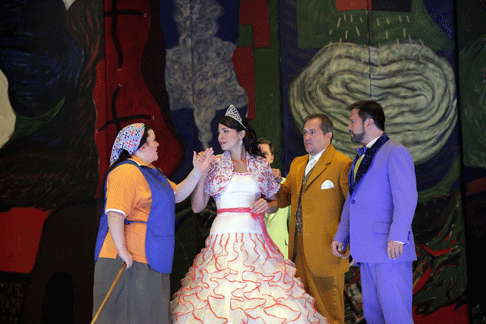 Meredith Arwady (Griselda), Isabel Leonard (Costanza), Paul Groves (Gualtiero) & David Daniels (Roberto)
Meredith Arwady (Griselda), Isabel Leonard (Costanza), Paul Groves (Gualtiero) & David Daniels (Roberto)
It is equally unlikely you would ever hear a more ravishing musical
rendition of Vivaldi’s seldom performed Griselda than the one on
display in New Mexico. My first encounter with this live version proved the
piece eminently “stage-worthy,” this in spite of Peter Sellars slack
direction. I so admire Mr. Sellars’ work that it pains me to say that on this
occasion he seemed to be re-cycling ideas from prior, far better productions.
The concept is that the piece is set in colonial New Mexico, all well and good.
To the production’s great credit the muralist Gronk has supplied a
mutli-faceted box set design with his signature (and dazzling) graffiti art
that boldly evokes the Southwestern milieu. And James F. Ingalls has devised an
eccentric lighting design that has a real point of view, even while keeping
Ottone and Costanza inexplicably in complete darkness for their first scene.
Still, his effects isolating the diverse elements of the mural showed
imagination and careful forethought. Dunya Ramicova’s costumes support the
concept with competent (if little more) designs.
But Mr. Sellars’ lack of fresh ideas hindered the piece from making its
full effect. Left with a bare stage, save a couple of straight back chairs,
Sellars rarely had the characters connect in any truthful way, the blocking
turgid, the pacing ineffective. Singers would complete spectacular accounts of
an aria and then just stroll off stage while the orchestra played the
(sometimes longish) final bars. Part of the audience, wanting to respond
enthusiastically (and deservedly so) would start to applaud and cheer the
departed soloist while the rest of us waited dutifully until the music was
completed to voice approval. It was an odd stop-and-go, surge-and-die dynamic
that could have, nay, should have been avoided with well timed direction.
Having Ottone dressed like he was from ‘da Hood’ was a reflux of past
programs, and reducing Griselda to a cleaning lady at opera’s end while the
off stage chorus extols her reunification with her husband was, well, cynical
at best. In place of the army of soldiers, two goons marched around the stage
like bug-sprayed roaches in a pinball machine, almost comically brandishing
machine guns at point blank range. Haven’t we seen this idea better presented
in past productions? Peter, please, please, clear your head, toss out the old,
and give us another insightful, cogent interpretation soon. We need your genius
back on full display.
That the cast was able to surmount the directorial shortcoming is a
testament to their brilliance. The incomparable David Daniels was a Roberto
without equal. His beefy, manly counter tenor (yes, manly) remains a wonder of
the modern world, his coloratura work exceptionally vivid, his legato passages
unparalleled, his commitment sincere and unforced. There have been many worthy
challengers to the throne, but Daniels remains the king of this repertoire.
Amanda Majeski is his equal as a thrilling Ottone. I hope fireworks are legal
in Santa Fe, because Ms. Majeski fires off unbelievably accurate salvos of
melismatic star bursts, turning out blazing Vivaldi phrases that work the
public up into a willing frenzy of excitement. Hers is a major talent in this
repertoire.
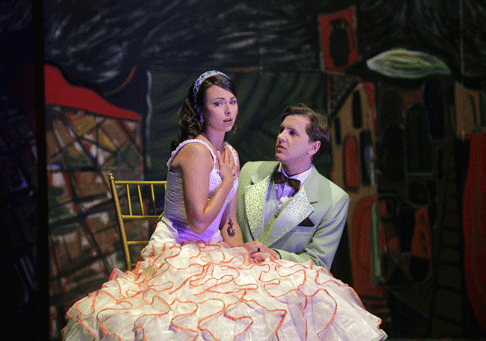 Isabel Leonard (Costanza) & Yuri Minenko (Corrado)
Isabel Leonard (Costanza) & Yuri Minenko (Corrado)
The lovely Isabel Leonard is no less a musical delight as the long-suffering
Costanza. Her lean, purely produced soprano is beautifully modulated to limn a
sympathetic character of dramatic interest and musical accomplishment. How
wonderful it was to hear the up-and-coming contralto Meredith Arwady break out
of her ‘featured roles’ status and knock our socks off as an impassioned
Griselda. Ms. Arwady seems to be successfully vying to assume the mantle of
Lili Chookasian, her rolling low register matched by a searing and well
controlled top. Yuri Minenko makes the most of Corrado’s brief role with a
mezzo of directness and accomplished technique. While I am a fan of Paul
Groves, he was not having his best night as Gualtiero. It just did not seem to
lie gratefully for his considerable gifts, and the fioriture was strained and
well behind the beat. Everything above the passaggio was a bit fuzzy, although
he managed some moving sotto voce phrases. Even with that caveat, Mr. Groves
delivered vivid, full voiced, well accented recitatives that were a model of
their kind.
In the pit, Grant Gershon could do no wrong. This was the high calibre of
instrumental playing that should be recorded to show future listeners how
exciting Griselda can be when everything goes miraculously right. For
the astounding musical accomplishments of these three offerings, Santa Fe can
luxuriate in its status as the grand daddy of US summer festivals.
James Sohre
Cast lists:
Faust
Faust: Bryan Hymel; MÈphistophÈlËs: Mark S. Doss; Wagner: Darik Knutsen;
Valentin: Christopher Magiera; SiÈbel: Jennifer Holloway; Marthe: Jamie
Barton; Marguerite: Ailyn PÈrez. Conductor: FrÈdÈric Chaslin. Director:
Stephen Lawless. Scenic Design: Benoit Dugardyn. Costume Design: Sue
Wilmington. Lighting Design: Pat Collins. Choreographer: Nicola Bowie. Chorus
Master: Susanne Sheston.
The Last Savage
Mr. Scattergood: Kevin Burdette; Maharajah: Thomas Hammons; Maharanee: Jamie
Barton; Kodanda: Sean Panikkar; Kitty: Anna Christy; Sardula: Jennifer Zetlan;
Abdul: Daniel Okulitch. Conductor: George Manahan. Director: Ned Canty. Scenic
and Costume Design: Allen Moyer. Lighting Design: Rick Fisher. Choreographer:
Se·n Curran. Chorus Master: Susanne Sheston.
Griselda
Gualtiero: Paul Groves; Griselda: Meredith Arwady; Ottone: Amanda Majeski;
Costanza: Isabel Leonard; Roberto: David Daniels; Corrado: Yuri Minenko.
Conductor: Grant Gershon. Director: Peter Sellars. Scenic Design: Gronk.
Costume Design: Dunya Ramicova. Lighting Design: James F. Ingalls.
image=http://www.operatoday.com/FST2_2197a.gif
image_description=Clockwise from top: Bryan Hymel (Faust), Mark Doss (MÈphistophÈlËs), Gabrielle Zucker (Helen of Troy), Kesa Huey (Cleopatra), Kristin Osler (Manon), Heidi Kershaw (Carmen), Hallie Brenner Dalsimer (Salome) & Jasmine Quinsier (Delilah) [Photo by Ken Howard courtesy of Santa Fe Opera]
product=yes
product_title=Santa Fe Musical Delights
product_by=Charles Gounod: Faust; Gian Carlo Menotti: The Last Savage & Antonio Vivaldi: Griselda
product_id=Above: Clockwise from top: Bryan Hymel (Faust), Mark Doss (MÈphistophÈlËs), Gabrielle Zucker (Helen of Troy), Kesa Huey (Cleopatra), Kristin Osler (Manon), Heidi Kershaw (Carmen), Hallie Brenner Dalsimer (Salome) & Jasmine Quinsier (Delilah)
All photos by Ken Howard courtesy of Santa Fe Opera